Basic AI Chatbot Pricing: A simple chatbot that can answer questions about a product or service might cost around $10,000 to develop.
Read More
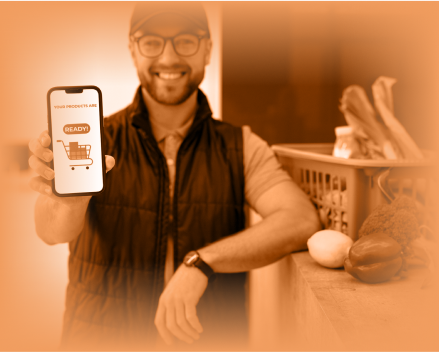
From ordering groceries, medicines, or your favorite meal - delivery expectations have changed forever. Today’s consumers want it now, and they want it personalized. That’s exactly where AI Hyperlocal Delivery Mobile App Development comes in.
At Biz4Group, we understand what it takes to build scalable, intelligent platforms that meet modern user demands. While our portfolio spans across industries, our work on a MERN-based, enterprise eCommerce platform, showcases deep expertise in last-mile visibility, route optimization, and third-party logistics integration. These capabilities form the backbone of any successful AI-powered hyperlocal delivery solution.
With AI algorithms now capable of real-time route optimization, demand forecasting, and automated dispatch, hyperlocal delivery is no longer just about proximity - it’s about precision, personalization, and performance. Here’s why AI in hyperlocal delivery is gaining massive traction:
These stats reflect the increasing reliance on AI for real-time decisions and route optimization.
This blog is your complete guide to AI Hyperlocal Delivery Mobile App Development - from must-have and advanced features to tech stack, monetization models, and cost breakdown.
Whether you’re a small business owner or an enterprise innovator, this guide will let you know everything about launching a successful AI hyperlocal delivery app.
AI Hyperlocal Delivery Mobile App Development is the process of building smart, location-based mobile applications that use artificial intelligence to manage real-time deliveries within a specific geographic radius — often just a few kilometers. If you’re planning such a project, here’s a detailed breakdown of the AI app development cost for a hyperlocal delivery app.
These solutions help businesses serve nearby customers faster and more efficiently by incorporating AI technologies such as route optimization, demand forecasting, automated dispatch, and dynamic delivery time estimations.
As opposed to traditional delivery systems, AI Hyperlocal Delivery App Development doesn’t just determine where to deliver, but also how and when to make that delivery in the most efficient way possible.
By using predictive algorithms, these apps can anticipate order surges, reduce delivery times, allocate resources intelligently, and enhance user satisfaction.
It’s no longer only about convenience - it’s about creating a delivery app using AI for your local business that is automated, scalable, and hyper-personalized, driving both user loyalty and business growth. Those ready to take the leap can explore our detailed guide on starting a hyperlocal eCommerce business using AI to understand the initial steps.
If you're still relying on traditional delivery models in 2025, you're not just behind the curve - you’re invisible to the growing audience for AI Hyperlocal Delivery Application Development.
From grocery runs and pharmacy drop-offs to instant meals, the age of “wait-and-watch” logistics is over. AI isn’t a “nice-to-have” anymore, it’s the competitive advantage your business needs if you’re launching a successful AI hyperlocal delivery app and stay ahead of competitors.
Today’s customers expect deliveries not just fast, but smart. They want to track their rider in real time, receive personalized product suggestions, and get accurate ETAs. This is exactly why you should develop a hyperlocal delivery app using AI - to meet these rising expectations effortlessly.
From managing peak hours to assigning the right delivery agents for the right orders, AI automates logistics in ways that reduce delivery time, fuel consumption, and human error.
Whether it's about managing peak hours or assigning the right delivery agents for the right orders, AI automates logistics in ways that reduce delivery time, fuel consumption, and human error. Working with specialized AI consulting services can help you identify the best automation strategies tailored to your business model.
The global AI in logistics market is projected to grow from $8.1 billion in 2023 to $65.3 billion by 2032. Investing now in Hyperlocal Delivery App Development with AI ensures you remain competitive for the long term.
Investing now in Hyperlocal Delivery App Development with AI ensures you remain competitive for the long term. To make this investment count, it’s worth exploring tips on how to hire the best eCommerce development company to ensure your project is in expert hands.
According to Allied Market Research, the global hyperlocal services market will hit $9,974 billion by 2032. AI is the fuel powering this growth, enabling businesses to expand smarter and faster.
For entrepreneurs planning to tap into this booming sector, investing in eCommerce store development is often the first step to building a scalable hyperlocal delivery platform.
AI optimizes inventory placement, predicts customer demand, and reduces delivery costs per order - all of which directly boost profitability.
Whether you're a restaurant chain, grocery aggregator, pharmacy chain, or local logistics startup, 2025 is the year to build an AI hyperlocal delivery app that delivers a truly intelligent customer experience.
Transform your local delivery business with AI-powered precision and real-time visibility.
Get Your Free ConsultationAt its core, an AI-powered hyperlocal delivery app connects nearby customers with local suppliers and service providers - whether it’s groceries, meals, prescriptions, or household essentials. But with AI Hyperlocal Delivery Mobile App Development, the real magic lies in how intelligently the entire ecosystem operates.
The business model typically revolves around three core elements:
When approaching AI Hyperlocal Delivery Mobile App Development, adopting an iterative, feedback-driven process ensures you can adapt quickly to market needs. That’s why many businesses prefer the Agile methodology for eCommerce projects to build, test, and refine their delivery platforms.
Instead of assigning the nearest available delivery agent randomly, AI considers traffic conditions, historical performance, and route density to optimize assignments in real time - a core advantage when you make your own AI-driven last-mile delivery platform.
AI predicts high-demand zones or time windows, allowing you to implement fair, data-backed surge pricing that boosts profitability without alienating users.
By analyzing browsing trends, seasonal shifts, and past orders, AI helps local vendors stock the right inventory - cutting waste and improving fulfillment rates.
Every customer sees a unique storefront tailored to their behavior, past orders, and location - something custom AI hyperlocal delivery mobile app development can deliver at scale.
Intelligent assistants can resolve delivery queries instantly, upsell during checkout, and reduce the load on human support teams. Businesses can further enhance engagement by integrating AI chatbots into hyperlocal delivery apps, enabling seamless 24/7 support and improved customer conversion rates.
The difference between a traditional delivery platform and one built through AI Hyperlocal Delivery App Development isn’t just about technology — it’s about delivering a superior user experience, operational efficiency, and business intelligence. Biz4Group’s comprehensive enterprise AI solutions make it possible to integrate these capabilities seamlessly into your delivery app.
| Aspect | Traditional Delivery App | AI Hyperlocal Delivery App |
|---|---|---|
|
Order Allocation |
Manual or proximity-based |
AI optimizes based on traffic, ETA, driver history |
|
Customer Experience |
One-size-fits-all UI |
Hyper-personalized based on user behavior & past orders |
|
Route Optimization |
Static mapping (GPS-only) |
Real-time AI-powered route updates |
|
Inventory Matching |
Basic availability-based |
Predictive engine suggests likely purchases |
|
Customer Support |
Call or manual chat |
AI chatbots for instant, context-aware help |
|
Analytics & Insights |
Basic admin dashboard |
Predictive analytics for demand & performance |
|
Scalability |
Manual configuration required |
Auto-adapts to new geographies and vendors using ML |
In 2025, speed and personalization define success. Traditional apps can deliver, but AI Hyperlocal Delivery Application Development can ensure smarter operations, lower last-mile delivery costs, and stronger customer loyalty.
Whether you plan to build AI hyperlocal delivery mobile applications for groceries, pharmacy logistics, or restaurant takeout, AI ensures you operate like a tech-first brand from day one. Partnering with an experienced AI development company in the USA like Biz4Group can help you turn that vision into a robust, market-ready product.
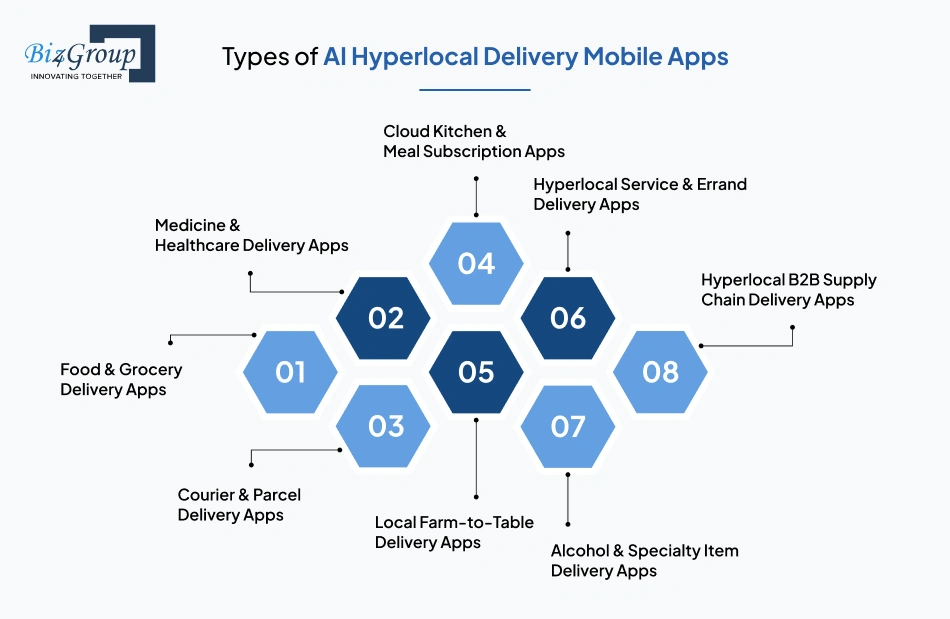
AI is not just powering one type of hyperlocal delivery model, it's transforming the entire ecosystem. Whether you're targeting consumers, businesses, or both, there’s a smart delivery app model that can work for your vision. Below are the most in-demand types of AI hyperlocal delivery apps you can build in 2025 through custom AI Hyperlocal Delivery Mobile App Development:
A platform that connects local restaurants, grocery stores, and consumers for rapid delivery within a specific area. AI takes this beyond basic ordering by predicting peak demand hours, recommending dishes or grocery items based on past purchases, and optimizing driver routes in real time.
These apps offer on-demand delivery of prescription and OTC products from nearby pharmacies. AI-powered prescription scanning with computer vision ensures accuracy, while urgency-based dispatch prioritizes emergency cases. AI also sends refill reminders and flags possible drug interactions.
Designed for peer-to-peer and business parcel delivery, these platforms use AI to detect package size and weight from images, set dynamic pricing, and optimize multi-stop delivery routes. AI also analyzes driver performance for better service quality.
Centralized kitchens prepare food exclusively for delivery, often offered through subscriptions. AI optimizes menus based on local tastes, predicts daily demand to reduce waste, and uses sentiment analysis on reviews to refine recipes.
Connecting farmers directly to local households and restaurants, these apps ensure the shortest supply chain possible. AI helps with harvest planning, price optimization, and freshness-based routing, while computer vision grades produce for quality.
These on-demand assistants handle tasks like laundry pickup, grocery runs, or local deliveries. AI understands natural language commands (“pick up my laundry and grab coffee”) and matches tasks to the most skilled agents.
Focused on regulated or premium products like alcohol, gourmet foods, or luxury goods, these apps use AI for age verification, taste-based recommendations, and compliance automation.
These apps enable rapid supply delivery for local businesses—think restaurants, salons, or repair shops needing urgent restocks. AI optimizes multi-stop deliveries, triggers auto-reorders when inventory runs low, and even predicts vehicle maintenance needs.
With the right custom AI hyperlocal delivery mobile app development strategy, these models can be tailored for your specific market, ensuring speed, personalization, and profitability from day one. For businesses ready to innovate, partnering with experts in AI product development can help bring these app ideas to life efficiently.
From groceries to pharmacy, launch a scalable AI delivery app tailored to your market.
Start Building Today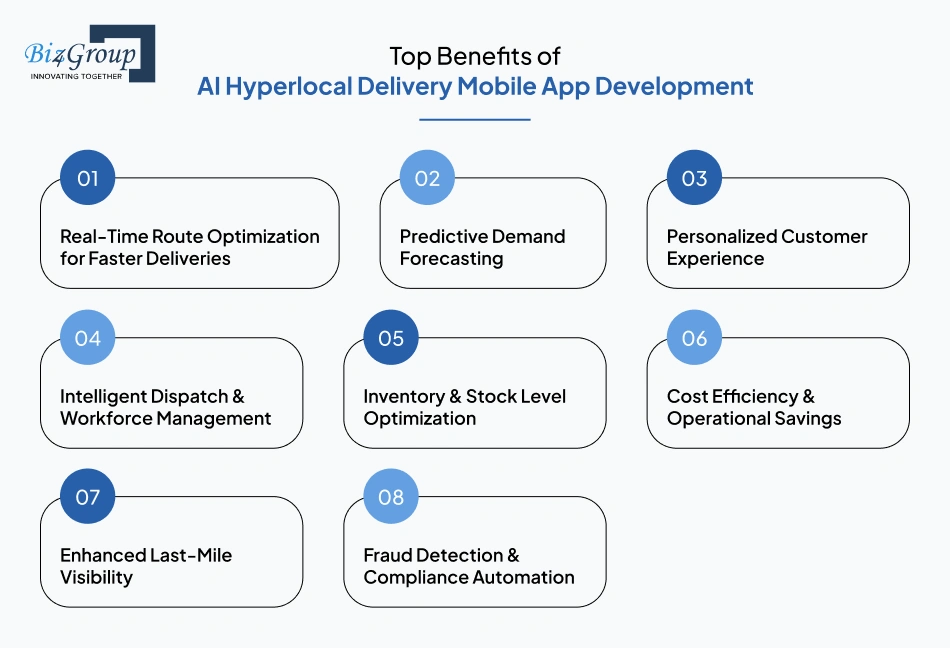
AI hyperlocal delivery apps are transforming the way businesses operate in the “order now, get now” economy. For creating your own solution, collaborating with a trusted AI app development company in the USA such as Biz4Group, can fast-track your success.
If you’re someone who’s planning to make your own AI-driven last-mile delivery platform, here are the top benefits that you’ll be enjoying:
AI algorithms analyze live traffic, weather, and delivery schedules to ensure drivers take the fastest, most efficient route possible. This means fewer delays and happier customers.
Example: Swiggy uses AI-based route optimization to cut delivery times and improve customer satisfaction.
Instead of reacting to orders, your app can predict them. AI models use historical sales, seasonal patterns, and local events to prepare inventory and staff ahead of time.
Example: BigBasket leverages predictive analytics to ensure stock availability before peak demand hits. To implement similar capabilities, you can hire AI developers for your hyperlocal delivery business who specialize in building and training predictive models.
AI tailors recommendations based on order history, preferences, and browsing behavior, making users feel understood and valued.
Example: Zomato suggests restaurants and dishes based on previous orders and cuisine preferences.
Your app can automatically assign deliveries to the most suitable driver based on location, capacity, and skill — reducing idle time and increasing efficiency.
Example: Dunzo’s AI dispatch system matches riders to orders in seconds, optimizing delivery flow.
For businesses with perishable or fast-moving products, AI can alert managers before items run out or spoil.
Example: Grofers uses AI to manage warehouse stocks efficiently, minimizing wastage.
By reducing failed deliveries, optimizing driver routes, and automating repetitive tasks, AI cuts down operational costs significantly. If you’re estimating your AI eCommerce Mobile App Development Cost, know that it’ll help you save more than you invest in the long run.
Example: Amazon’s AI-powered logistics has saved millions annually in transportation expenses.
Track orders in real time with AI-powered dashboards, enabling proactive customer updates and reducing “where’s my order?” calls.
Example: Domino’s “Pizza Tracker” is a simple but highly effective form of last-mile visibility. To keep innovating, businesses should stay updated on the latest trends in AI product development that can further enhance delivery tracking and customer engagement.
AI can flag suspicious transactions, prevent fake orders, and ensure regulatory compliance automatically.
Example: Alcohol delivery apps like Drizly use AI to verify customer age and prevent underage sales.
With benefits spanning from customer satisfaction to operational excellence, AI-powered hyperlocal delivery apps don’t just keep pace with the market — they set the standard. Let’s now explore the must-have features that make such apps truly stand out.
Also Read: How to Develop AI Quick Commerce App? Features and Process
When building an AI Hyperlocal Delivery Mobile App, these features form the backbone of a smooth, intelligent, and scalable delivery ecosystem. They aren’t just “good to have” - they’re the core functionality your customers will expect from day one.
Deliveries are no longer about “it’s on the way” - customers want to know exactly where their order is and when it will arrive. That’s exactly why you should develop a hyperlocal delivery app with AI. With live tracking you can get dynamic ETAs that adjust in real time based on traffic, weather, and driver progress.
Gone are the days of scrolling through endless options. NLP-enabled search lets users type or speak natural phrases like “organic strawberries under $5,” instantly filtering results based on their intent.
Also Read: How to Build AI Shopping Assistant App: A Complete Guide
AI automatically matches orders to the most suitable delivery agents based on proximity, delivery load, route conditions, and past performance — reducing delivery times and improving efficiency.
Pricing that adapts in real time based on demand, urgency, and distance helps balance profitability with customer satisfaction, especially during peak hours.
Customers and delivery partners can connect via AI-assisted chat or calls. The system can detect urgent situations (like incorrect orders) and escalate them instantly. Auto-generated FAQs and responses reduce time spent on common queries like delivery ETA or payment confirmation.
Businesses can also leverage AI integration services to embed intelligent communication tools directly into their hyperlocal delivery platforms.
Multiple payment options, digital wallets, and one-tap payments make checkout frictionless and fast, directly impacting conversion rates. As part of this, ensuring PCI compliance for eCommerce stores is crucial to safeguard sensitive payment data and maintain customer trust.
Predicts demand patterns for different products, alerts merchants before stocks run out, and even suggests restocking timelines.
AI tailors notifications based on user activity — from timely delivery updates to personalized offers, boosting retention and repeat orders.
AI remembers past orders and recommends repeat purchases or complementary items to make the next order faster and more engaging.
Separate dashboards for admins, delivery agents, merchants, and customers ensure operational clarity and prevent workflow bottlenecks.
| Feature | Quick Explanation |
|---|---|
|
AI-Powered Real-Time Tracking |
Live ETAs with dynamic adjustments based on traffic and conditions. |
|
Smart Search & Filters |
NLP-powered search for quick, intent-based results. |
|
Predictive Order Assignment |
Matches orders to the most suitable driver in real time. |
|
Dynamic Pricing Models |
Adjusts prices based on demand, urgency, and location. |
|
In-App Communication Tools |
Chat/call features with AI for urgent escalations. |
|
Seamless Payment Integration |
Multiple payment modes with one-tap checkout. |
|
AI-Driven Inventory Management |
Predictive restocking to avoid stockouts. |
|
Push Notifications & Alerts |
Personalized updates and offers for users. |
|
Order History & Reordering |
One-tap repeat orders with smart suggestions. |
|
Multi-User Role Access |
Role-specific dashboards for smooth operations. |
Also Read: How to Build an Ecommerce Website Using AI?
Once you’ve nailed the core features, advanced functionality is where AI Hyperlocal Delivery Mobile App Development truly stands out from traditional delivery apps. These features help you differentiate your platform, boost user engagement, improve operational efficiency, and increase ROI over time.
Beyond GPS navigation, AI dynamically re-routes drivers in real time by considering live traffic updates, road closures, weather disruptions, and delivery priority.
AI analyzes past order data, local events, and seasonal trends to predict spikes in demand and align inventory accordingly.
Allows users to upload or snap a picture of an item to instantly find similar products from partner stores.
Integrates AI-powered voice recognition so users can place orders, track deliveries, and search for products hands-free.
AI assigns deliveries to available drivers in real time, factoring in order urgency, proximity, delivery load, and driver performance metrics.
Identifies unusual ordering patterns, payment anomalies, or suspicious account activity to prevent fraudulent transactions.
AI suggests add-ons and complementary products at checkout to increase cart value without feeling intrusive.
Tracks delivery speed, on-time rates, customer feedback, and route efficiency for each driver.
AI translates app content, push notifications, and chat messages into the user’s preferred language.
IoT-enabled sensors in delivery vehicles or storage units can transmit real-time data about temperature, location, and condition of goods.
| Advanced Feature | Quick Explanation |
|---|---|
|
AI-Driven Route Optimization |
Real-time re-routing based on traffic, weather, and priority. |
|
Demand Prediction & Inventory Forecasting |
Predicts demand spikes to prevent stockouts and waste. |
|
Visual Search & Image Recognition |
Finds products from user-uploaded images. |
|
Voice-Enabled Ordering & Assistance |
Hands-free ordering with AI voice recognition. |
|
Automated Dispatch Management |
AI assigns deliveries efficiently in real time. |
|
AI-Powered Fraud Detection |
Detects and prevents suspicious transactions. |
|
Personalized Upselling & Cross-Selling |
Relevant add-on suggestions to boost cart value. |
|
Real-Time Driver Performance Monitoring |
Tracks driver metrics for efficiency and quality. |
|
Multi-Language & Localization Support |
AI-powered language translation for broader reach. |
|
Integration with IoT Devices |
Monitors goods' conditions in real time for quality control. |
Having discussed all the basic and advanced features, let’s move ahead and talk about the steps involved in creating a delivery app using AI for your local business.
Lead the hyperlocal delivery race with an AI-powered app built for speed and personalization.
Start My Project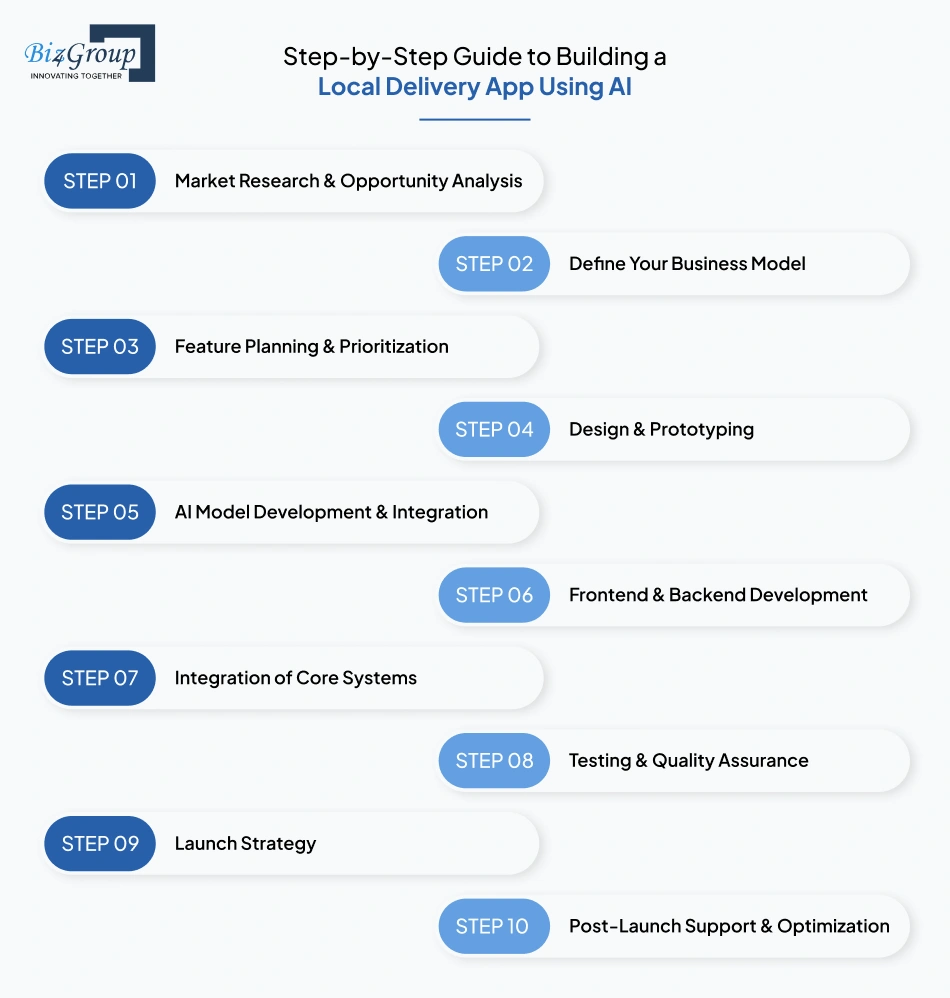
Building an AI hyperlocal delivery mobile app involves more than just combining GPS with order management, it’s about creating a smart, adaptable ecosystem that anticipates needs and optimizes operations from day one. So, what is the process to create AI Hyperlocal Delivery Apps? Let’s get into the details:
Understanding your target audience, local delivery patterns, and competitive landscape lays the foundation for AI Hyperlocal Delivery Mobile App Development. This stage helps you uncover gaps AI can fill for maximum value creation.
Choosing the right delivery model and revenue strategy ensures your app is both sustainable and scalable. It’s the blueprint that guides how technology meets profitability.
An effective feature plan balances what your users want today with the flexibility to evolve tomorrow. Start lean but design with scale in mind.
This is where user experience meets technical architecture. An intuitive interface backed by scalable infrastructure ensures adoption and smooth operations.
Your AI models are the intelligence core of the app. They turn raw data into actionable insights that improve speed, personalization, and efficiency.
Also Read: An Enterprise Guide to AI Model Development from Scratch
This stage transforms your designs and AI logic into a functional application. Choosing the right tech stack ensures compatibility, performance, and longevity.
Integrations connect your app to essential third-party services and enhance its functionality without reinventing the wheel.
Thorough testing guarantees that your app performs flawlessly under real-world conditions. This step helps you avoid costly post-launch issues during AI Hyperlocal Delivery Mobile App Development.
Also Read: Software Testing Companies in USA
A strategic rollout maximizes initial adoption and sets the tone for long-term success. Soft launches allow you to refine before scaling.
Sustaining success requires constant iteration. This phase ensures your app remains competitive as market expectations evolve.
| Step | Purpose |
|---|---|
|
Market Research & Opportunity Analysis |
Identify niche demand and opportunities for AI-driven improvements. |
|
Define Your Business Model |
Establish operational and revenue strategy. |
|
Feature Planning & Prioritization |
Create an adaptable feature set with clear priorities. |
|
Design & Prototyping |
Blend intuitive UI/UX with scalable architecture. |
|
AI Model Development & Integration |
Implement intelligence for optimization, forecasting, and personalization. |
|
Frontend & Backend Development |
Build high-performance, cross-platform applications. |
|
Integration of Core Systems |
Connect with payments, GPS, and notification services. |
|
Testing & QA |
Ensure security, usability, and performance under load. |
|
Launch Strategy |
Optimize adoption with targeted rollouts and KPI tracking. |
|
Post-Launch Support |
Maintain competitiveness through updates and customer support. |
Choosing the right tech stack is a critical step in AI Hyperlocal Delivery Mobile App Development, as it determines your app’s scalability, speed, and ability to integrate AI capabilities seamlessly. The right tools not only improve development efficiency but also ensure long-term adaptability to evolving market needs.
Your frontend is the bridge between your users and the technology running behind the scenes. It needs to be responsive, intuitive, and consistent across devices.
The backend powers your app’s functionality, handling orders, processing payments, and managing AI-driven recommendations.
These tools bring intelligence to your app, enabling smart recommendations, route optimization, and predictive analytics.
The database stores and retrieves data instantly to keep the app responsive, even during peak demand.
These services ensure precise location tracking, route mapping, and ETA predictions.
Secure, fast, and user-friendly payment integration is essential for smooth transactions.
Cloud services keep your app available, secure, and scalable without heavy upfront investment.
Engaging customers through real-time updates and alerts keeps them coming back.
| Category | Recommended Tools/Technologies |
|---|---|
|
Frontend |
React Native, Flutter, Swift, Kotlin |
|
Backend |
Node.js, Python (Django/Flask), Java (Spring Boot) |
|
AI/ML Frameworks |
TensorFlow, PyTorch, Scikit-learn |
|
Database |
PostgreSQL, MongoDB, Redis |
|
Mapping APIs |
Google Maps API, Mapbox, HERE API |
|
Payment Gateways |
Stripe, PayPal, Razorpay |
|
Cloud Hosting |
AWS, Google Cloud, Microsoft Azure |
|
Notifications |
Firebase, Twilio, OneSignal |
The cost of developing an AI Hyperlocal Delivery Mobile App in 2025 depends on multiple factors - from core features and AI sophistication to platform choice (Android, iOS, or both). On average, a basic app can cost around $25,000, while enterprise-grade platforms with advanced AI features may go well beyond $300,000. Businesses also need to factor in ongoing maintenance, cloud hosting, and AI model updates to keep the platform competitive.
Here’s a breakdown of the key elements that influence total cost:
| Component | Estimated Cost (USD) | Notes |
|---|---|---|
|
Research & Planning |
$2,000 – $5,000 |
Competitor analysis, feature mapping, tech strategy |
|
Design (UI/UX) |
$4,000 – $8,000 |
Interactive prototypes, branding, visual design |
|
App Development – Single Platform (Android or iOS) |
$10,000 – $20,000 |
Frontend + backend for one platform |
|
App Development – Dual Platform (Android + iOS) |
$18,000 – $35,000 |
Broader reach, higher cost |
|
AI Model Development & Integration |
$6,000 – $15,000 |
Includes AI training, testing, and deployment |
|
Testing & QA |
$2,000 – $4,000 |
Manual + automated testing |
|
Post-Launch Support & Updates |
$1,500 – $3,500 / month |
Maintenance, AI updates, feature enhancements |
For those who’re looking for a scale-wise categorization for AI Hyperlocal Delivery Mobile App Development, here’s the tier-based breakdown:
| Category | Estimated Cost (USD) | What’s Included |
|---|---|---|
|
MVP (Minimum Viable Product) |
$25,000 – $50,000 |
Basic delivery tracking, simple AI-based recommendations, single platform (Android or iOS), minimal design customization. Ideal for testing market response. |
|
Mid-Level App |
$50,000 – $150,000 |
Dual-platform (Android + iOS), advanced AI features like predictive demand forecasting, real-time route optimization, and AI chatbots. Includes polished UI/UX and backend integrations. |
|
Enterprise-Grade Solution |
$150,000 – $300,000+ |
Scalable architecture, multi-location & multi-vendor support, fully customized AI models, integrations with ERP/CRM, AR/VR capabilities, and complex analytics dashboards. Built for high-volume operations. |
Also Read: Top 12+ MVP Development Companies in USA
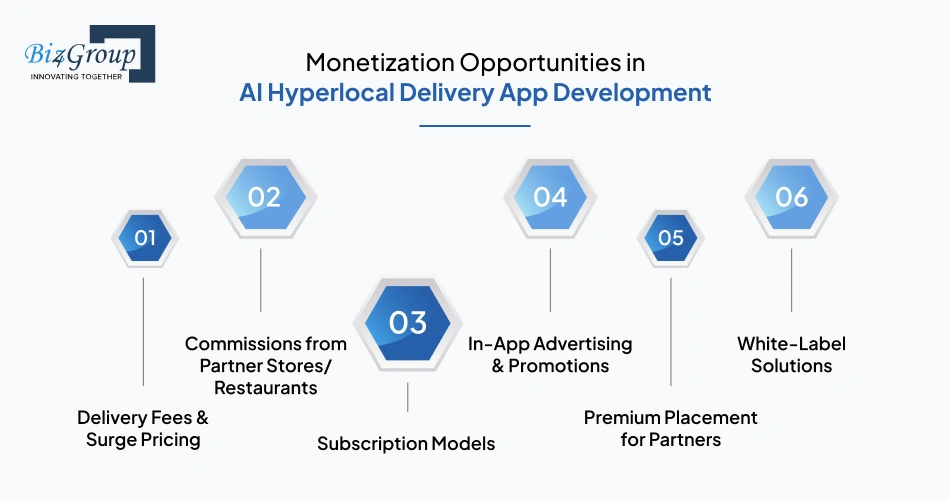
Now, how to build AI Hyperlocal Delivery Mobile App that you can monetize?
Well, by leveraging AI’s ability to predict, personalize, and optimize, you can unlock multiple income streams that grow alongside your user base. Let’s talk about a couple of channels that help make it happen:
Delivery charges remain one of the most straightforward monetization avenues. With AI, these charges can be dynamically adjusted based on factors like delivery time, traffic, weather conditions, and demand peaks—maximizing both revenue and customer satisfaction.
By collaborating with local stores and restaurants, you can earn commissions on each sale generated through your platform. AI enhances these partnerships by driving more sales through precise product recommendations and data-driven insights.
Also Read: Top 15 AI Product Development Companies in USA
A subscription or membership plan can provide stable recurring income. AI helps by personalizing benefits for each subscriber, making the membership feel tailored and increasing retention rates.
Your app can become a targeted advertising platform for local businesses. AI ensures these ads are hyper-relevant, increasing the value for advertisers and creating a better user experience for customers.
Businesses will pay more for better visibility within your app. AI ensures this placement aligns with user behavior, so featured spots drive meaningful engagement instead of being wasted impressions.
If your AI platform architecture is flexible, you can license it to other businesses under a white-label agreement. AI-driven customization makes it easy to adapt the platform to various industries and use cases.
By combining AI-driven personalization, dynamic pricing, and strategic partnerships, you can ensure a consistent cash flow while building long-term brand loyalty. With a sustainable revenue model in place, the next step in AI Hyperlocal Delivery Mobile App Development is to address the challenges that could stand in the way of scaling your app successfully.
Also Read: Top 15 UI/UX Design Companies in USA: 2025 Guide
Grow your delivery business with enterprise-grade AI features that adapt as you scale.
Scale with AI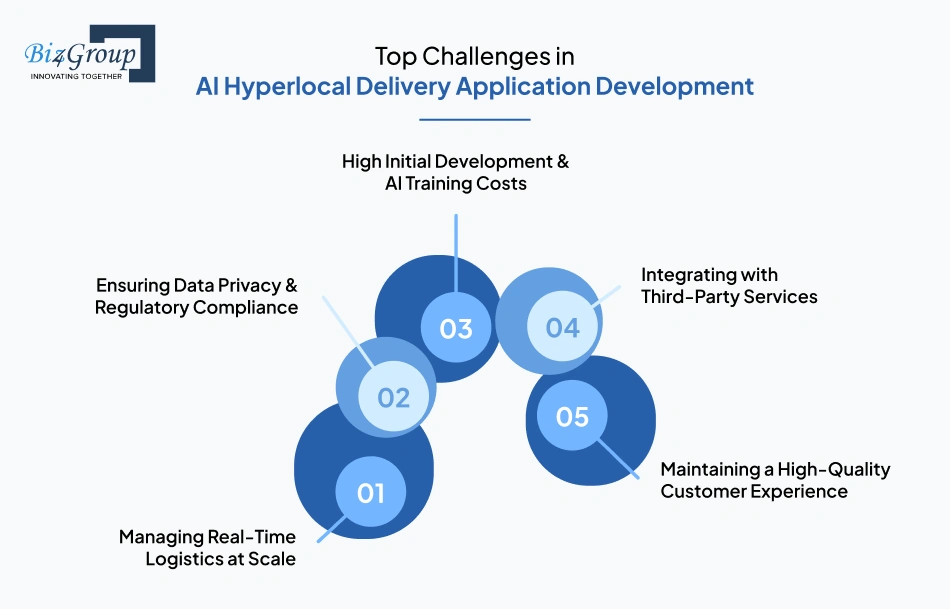
Even the most profitable monetization plan can hit roadblocks if your app fails to overcome operational, technical, and market-related challenges. AI Hyperlocal Delivery Mobile App Development demands speed, accuracy, and reliability - all while scaling seamlessly and staying compliant.
Here are some of the most pressing challenges developers face as they build AI hyperlocal delivery apps and the strategies to solve them.
Hyperlocal delivery thrives on immediacy, but scaling to handle high volumes without delays can be daunting. AI-powered route optimization, live tracking, and predictive traffic analysis can mitigate this challenge.
Handling customer addresses, payment data, and location tracking means adhering to strict privacy regulations like GDPR or CCPA. Failure to comply can lead to penalties and loss of customer trust.
Building an AI-powered platform involves significant upfront costs, especially for training machine learning models and integrating real-time analytics.
Hyperlocal apps often rely on multiple APIs - payment gateways, mapping tools, inventory systems. Ensuring smooth integration without downtime is a major challenge.
Even with flawless logistics, poor UX can drive users away. Personalization, intuitive navigation, and seamless support are key.
Also Read: How to Build Custom AI Chatbot for eCommerce Websites?
At the core of any successful AI hyperlocal delivery app lies a solid, scalable, and intelligent infrastructure - something Biz4Group has already mastered with its flagship enterprise eCommerce platform, Biz4Commerce. Built on a MERN-based headless architecture, Biz4Commerce® is designed for flexibility, high performance, and seamless integration, enabling businesses to scale their ecommerce operations while maintaining lightning-fast responsiveness.
What makes Biz4Group particularly relevant for AI-driven hyperlocal delivery is its last-mile visibility, delivery delay prediction, route optimization, and third-party logistics integration capabilities.
By leveraging these proven logistics and integration strengths, Biz4Group can deliver hyperlocal delivery solutions that:
Backed by 20+ years of leadership experience, 700+ successful projects, and partnerships with Fortune 500 clients, Biz4Group is a strategic partner in crafting intelligent delivery ecosystems. From conceptualization to deployment and post-launch scaling, it's ensured that every app is built for performance, personalization, and profitability.
If your goal is to dominate your local market with precision deliveries, smarter routes, and unmatched customer experiences, the next move is clear - build it with a team that’s already mastered the playbook.
Transform customer experiences with AI-powered precision, personalization, and real-time tracking.
Build My AI Delivery AppWith consumers demanding faster fulfillment, personalized experiences, and real-time visibility, the winners in this market will be those who can combine cutting-edge AI capabilities with rock-solid delivery infrastructure in their AI Hyperlocal Delivery Mobile App Development projects.
At Biz4Group, we’ve proven our expertise in this space through enterprise-grade solutions like Biz4Commerce®, built to handle high-volume transactions, integrate with third-party logistics, and provide last-mile visibility with features like delivery delay prediction and route optimization.
Whether you’re a startup looking for a lean MVP, a mid-size company ready to scale, or an enterprise aiming for total market dominance, we know how to align AI technology with your business goals to maximize ROI.
The hyperlocal delivery race is heating up and the real question is whether you’ll be leading it or chasing the leaders. If you’re ready to be in the driver’s seat, let’s start building the platform that puts your brand ahead of the curve.
Schedule a Free Call Now to get a headstart!
AI improves hyperlocal delivery accuracy by analyzing real-time traffic, historical delivery data, and customer preferences to suggest the fastest, most efficient routes. It also predicts demand patterns, reducing missed or delayed deliveries.
Many sectors can leverage AI hyperlocal delivery, but these see the highest impact:
Not necessarily. While initial development can be costly, AI automation reduces manual dispatching, optimizes resource allocation, and minimizes fuel wastage—significantly lowering operational expenses over time.
AI uses predictive analytics to anticipate demand surges—like lunch rushes for food delivery or festival shopping spikes—and automatically adjusts driver allocation, delivery batching, and routes to handle the load efficiently.
Yes, most AI hyperlocal delivery apps can connect with POS, ERP, or inventory management software via APIs, allowing businesses to sync orders, stock levels, and delivery status in real-time without manual updates.
A well-developed AI hyperlocal delivery app uses encryption, access controls, and compliance with regulations like GDPR or CCPA to protect sensitive customer information, from delivery addresses to payment details.
with Biz4Group today!
Our website require some cookies to function properly. Read our privacy policy to know more.